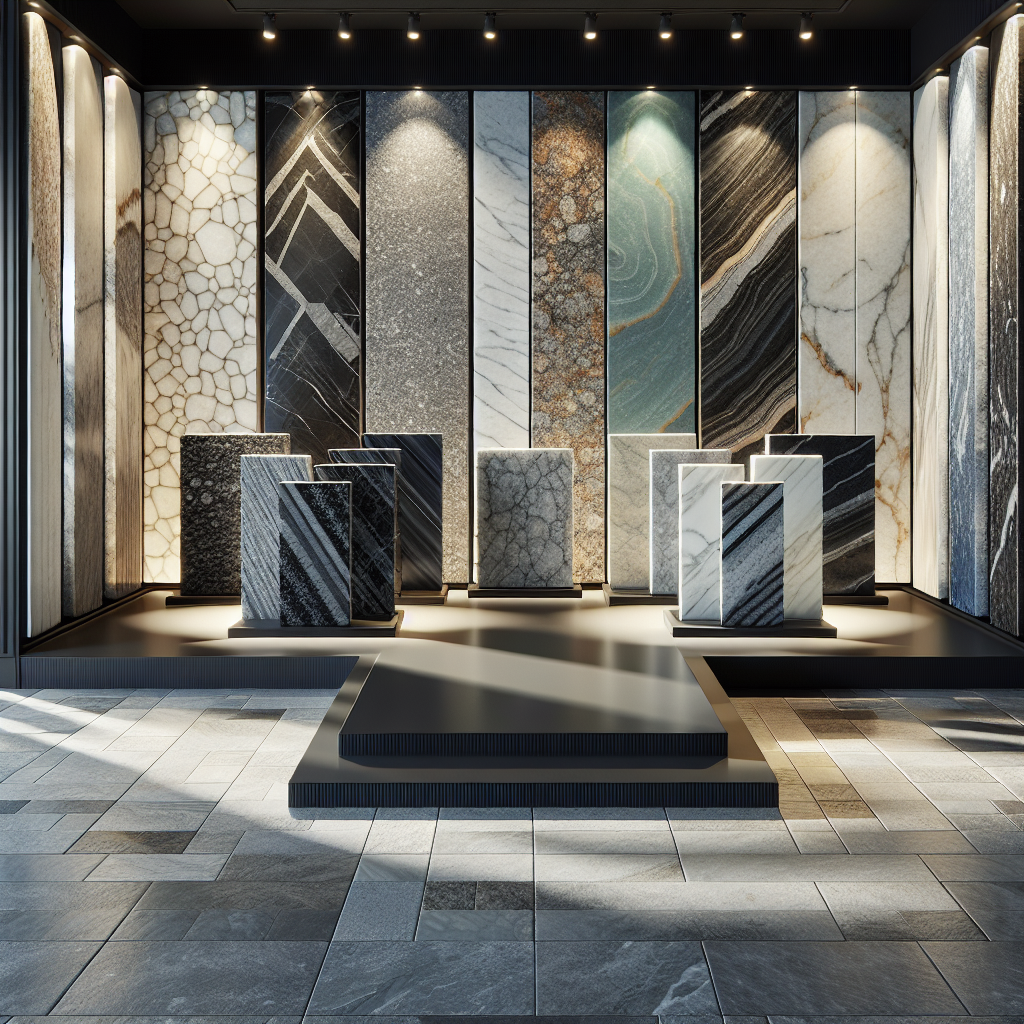Granite countertops have become a popular choice for homeowners due to their durability, elegance, and timeless beauty. Fabricating granite countertops involves several meticulous steps that ensure the end product is not only visually appealing but also highly functional. Understanding these steps can help both homeowners and contractors make informed decisions when selecting and installing granite countertops.
In the world of kitchen remodeling, granite stands out for its unique patterns and exceptional strength. The process of fabricating granite countertops starts with selecting the right slab. Each slab of granite is unique, with its own set of colors, patterns, and textures. This makes it essential to choose a slab that complements the overall design of your kitchen.
Once the slab is selected, the next step involves precise measurements and templating. This ensures that the granite countertop will fit perfectly into the designated space, with cutouts for sinks and appliances accurately positioned. State-of-the-art technology, such as CNC machines and water jet cutters, are used to achieve the highest level of precision during the cutting process.
After cutting, the edges of the granite countertop are polished to give them a smooth and finished look. Different edge profiles, such as bullnose, bevel, and ogee, can be chosen to add a personalized touch to the countertop. Finally, the granite countertop is sealed to protect it from stains and spills, ensuring it remains pristine for years to come.
At Absolute Marble and Granite, we are dedicated to providing top-notch fabrication and installation services. Call us today at (954) 781-7370 for a free quote!
Choosing the Right Granite Slab

Choosing the right granite slab is a crucial step in the process of fabricating granite countertops. The selection not only impacts the aesthetic appeal of your kitchen but also its functionality and longevity. Granite slabs come in a variety of colors, patterns, and textures, making it essential to find one that aligns with your design vision and practical needs.
When selecting a granite slab, consider the color and pattern. Granite is available in a wide range of hues, from classic blacks and whites to vibrant blues and greens. The pattern can vary from uniform speckles to dramatic veining. It’s important to choose a slab that complements the existing color scheme and style of your kitchen.
Another key factor is the quality of the granite. High-quality granite slabs have fewer imperfections and are more durable. Inspect the slab for any fissures, cracks, or pits that could affect its structural integrity. It’s also advisable to check the thickness of the slab, as thicker granite is generally more robust and better suited for heavy-duty use.
Texture is another consideration. Granite slabs can have different finishes, such as polished, honed, or leathered. A polished finish gives a shiny, reflective surface that enhances the stone’s natural colors, while a honed finish offers a matte look that is less prone to showing scratches. A leathered finish provides a textured surface that adds a unique tactile experience.
Once you’ve considered these factors, it’s wise to view the slab in person. Lighting can greatly affect the appearance of granite, so seeing it under different lighting conditions can help you make a more informed decision. By taking the time to choose the right granite slab, you ensure that your countertop will be a stunning and durable addition to your kitchen.
Essential Tools for Fabrication
Having the right tools is paramount when it comes to fabricating granite countertops. The process requires precision and attention to detail, and utilizing the appropriate equipment can make all the difference in achieving a flawless finish.
One of the most important tools is a diamond saw blade, which is essential for cutting through the hard granite material. Diamond blades are known for their durability and efficiency, making clean, precise cuts possible. Additionally, a wet saw with a diamond blade helps reduce dust and keeps the blade cool, prolonging its life.
For shaping and smoothing the edges, a router equipped with diamond-tipped bits is indispensable. Routers allow for intricate edge profiles, from simple beveled edges to more complex ogee or bullnose designs. Using a high-quality router ensures that the edges are smooth and free of chips.
Another crucial tool is a polishing pad. Polishing pads, often made of diamond or resin, are used in conjunction with a hand polisher or grinder to achieve a mirror-like finish on the granite surface. These pads come in varying grits, starting from coarse to fine, allowing for a gradual polish that enhances the natural beauty of the stone.
Safety equipment should not be overlooked. Protective gear such as safety goggles, gloves, and dust masks are essential to protect against flying debris and dust generated during the fabrication process. Additionally, ear protection is important when operating loud machinery.
Finally, measuring tools like a tape measure, straight edge, and level are fundamental in ensuring accuracy during the fabrication process. Precise measurements are crucial to ensure that the countertop fits perfectly within the designated space and aligns seamlessly with your kitchen’s layout.
By investing in these essential tools, you can ensure that the fabrication process is efficient, safe, and yields the high-quality results that granite countertops are known for.
Step-by-Step Fabrication Process

The fabrication of granite countertops is a meticulous process that requires a step-by-step approach to ensure precision and quality. Here’s an overview of the key steps involved:
1. Template Creation: The first step is to create a template of the countertop area. This is typically done using thin strips of wood or cardboard to outline the exact dimensions and shape of the countertop. Accuracy at this stage is crucial, as the template will guide all subsequent steps.
2. Selecting the Slab: With the template in hand, the next step is to choose the granite slab. Consider the aesthetic preferences, including color, pattern, and veining. It’s important to inspect the slab for any imperfections and ensure it complements the overall design of your kitchen.
3. Cutting the Slab: Using a diamond saw blade, the granite slab is cut according to the template. Precision is key to avoid any mistakes that could result in wasted material. A wet saw is often used to minimize dust and keep the blade cool.
4. Shaping the Edges: Once the slab is cut, the edges are shaped using a router with diamond-tipped bits. This step allows for the creation of various edge profiles, from simple to intricate designs. Smooth, chip-free edges are essential for a polished look.
5. Polishing: The surface and edges of the granite are then polished using diamond or resin polishing pads. Starting with coarse grit and progressing to finer grits, the granite is polished to a high shine, enhancing its natural beauty and ensuring a smooth surface.
6. Cutouts: Any necessary cutouts for sinks, faucets, or cooktops are made at this stage. Precision tools are used to ensure that these cutouts are accurate and clean.
7. Quality Inspection: Before installation, a thorough inspection is conducted to ensure that the granite meets quality standards. Any imperfections are addressed, and the slab is cleaned and prepared for transport.
8. Installation: The final step is the installation of the countertop. The granite is carefully positioned and secured in place, ensuring that it fits perfectly and is level. Seams are sealed, and the countertop is given a final polish to ensure a flawless finish.
Following this detailed fabrication process ensures that your granite countertops are not only beautiful but also durable and perfectly suited to your kitchen space.
Polishing and Finishing Techniques

When it comes to fabricating granite countertops, the polishing and finishing techniques are pivotal in achieving a stunning and durable surface. Here are the essential methods used to ensure a flawless finish:
1. Initial Grinding: The process starts with coarse grinding to remove saw marks and any roughness from the surface. Diamond grinding pads with a grit size of around 50 are typically used. This step lays the foundation for a smooth finish by leveling the surface.
2. Progressive Polishing: Polishing granite involves a series of progressively finer diamond polishing pads. Starting with a 100-grit pad, and progressing through 200, 400, 800, and finally up to 3,000-grit pads, each stage refines the surface further. This gradual process ensures that the granite’s natural beauty is brought out while achieving a glossy finish.
3. Wet Polishing: To minimize dust and keep the polishing pads cool, wet polishing is often employed. Water is continuously sprayed on the granite surface during the polishing process. This not only controls dust but also prevents the granite from overheating, which can cause damage.
4. Edge Polishing: The edges of the granite countertops also receive special attention. Using smaller, handheld polishing tools, the edges are meticulously polished to match the surface’s finish. This step is crucial for creating a cohesive and professional look.
5. Sealing: After polishing, the granite surface is sealed to protect it from stains and moisture. High-quality penetrating sealers are applied to ensure the granite remains impermeable and maintains its luster over time. Sealing not only enhances the granite’s appearance but also extends its lifespan.
6. Buffing: The final step in the polishing process is buffing. Using a high-speed buffer, the granite surface is buffed to a high sheen. This step removes any residual polish and gives the granite its ultimate glossy finish.
These polishing and finishing techniques are essential for ensuring that your granite countertops are not just visually appealing but also durable and easy to maintain. By following these meticulous steps, craftsmen can transform rough granite slabs into elegant, polished surfaces that enhance any kitchen’s aesthetic appeal.
Maintenance Tips for Granite Countertops
Granite countertops are known for their durability and timeless beauty, but maintaining that elegance requires some care and attention. Here are some essential maintenance tips for granite countertops to keep them looking pristine:
1. Regular Cleaning: Clean your granite countertops daily using a mild dish soap and warm water. Avoid using abrasive cleaners or harsh chemicals, as they can damage the sealant and dull the surface. A soft cloth or sponge should be sufficient for wiping down the countertops.
2. Immediate Spill Cleanup: Granite is resistant to many substances, but prolonged contact with acidic or oily spills can cause stains. Wipe up spills immediately to prevent them from seeping into the stone. Common culprits include wine, coffee, and citrus juices.
3. Use Cutting Boards: While granite is hard and durable, using cutting boards can prevent potential scratches and protect the finish. Additionally, cutting directly on the granite can dull your knives.
4. Avoid Heat Damage: Granite can withstand high temperatures, but it’s still wise to use trivets or hot pads under hot pots and pans to avoid thermal shock, which can cause cracks or discoloration.
5. Regular Sealing: To maintain the granite’s resistance to stains and moisture, it’s essential to reseal it periodically. Depending on the type of granite and the quality of the sealer used, this may be required every 1 to 3 years. Check the surface by sprinkling a few drops of water; if the water doesn’t bead up, it’s time to reseal.
6. Avoid Sitting on Countertops: While granite is incredibly strong, excessive weight, especially along the edges, can cause cracks. Discourage sitting or standing on your granite countertops to avoid potential damage.
7. Polishing: Occasionally, you may want to polish your granite countertops to maintain their shine. Use a granite-specific polish and follow the manufacturer’s instructions for the best results.
By following these maintenance tips, you can ensure that your granite countertops remain as stunning as the day they were installed. Proper care not only preserves their beauty but also extends their lifespan, making them a lasting investment in your home.
Call us today at (954) 781-7370 for a free quote! Or visit our website at Absolute Marble and Granite to learn more about our exceptional countertop solutions.
